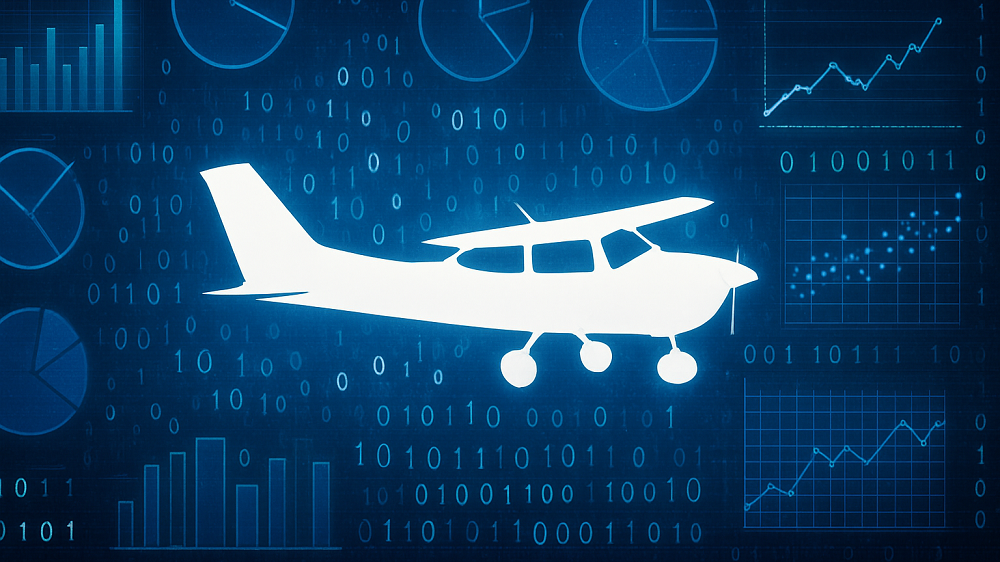Aviation safety has always been a top priority, and today, technology is pushing those safety standards even higher. One of the most powerful tools shaping the future of safe flying is big data. While it may sound like a buzzword, big data simply means collecting and analyzing large volumes of information to find patterns and make better decisions.
For student pilots and new private pilots, understanding how big data is used in aviation may seem like something that only applies to airliners or government agencies. But the truth is that big data plays an increasing role at every level of aviation, including general aviation. It affects everything from aircraft maintenance and air traffic control to weather forecasting and pilot performance.
What Is Big Data?
Big data refers to extremely large datasets that can be analyzed by computers to reveal patterns, trends, and associations. In aviation, this data might include:
- Aircraft engine performance
- Flight paths and traffic data
- Weather records and forecasts
- Maintenance logs
- Air traffic communications
- Safety reports and pilot feedback
The key to big data is not just that the information is large, but that it is constantly being collected, updated, and analyzed using advanced software tools.
For example, every time an aircraft takes off, it generates data through its avionics systems, sensors, GPS, and even onboard cameras or microphones. That data is recorded, transmitted, and stored. When analyzed together with data from other flights, it can reveal trends that would be impossible to detect from a single event.
Where Does Aviation Data Come From?
Aviation data is collected from a wide variety of sources. Some of the most common include:
1. Flight Data Recorders
Often called “black boxes,” these record detailed information about each flight, including airspeed, altitude, heading, engine performance, and control inputs.
2. ADS-B and Radar Systems
Modern aircraft broadcast their position, speed, and altitude through ADS-B. Ground radar also tracks aircraft movement. This creates a record of every flight’s path and proximity to others.
3. Maintenance Systems and Sensors
Aircraft systems constantly monitor the health of components such as engines, hydraulics, and electronics. These systems can detect signs of wear or failure long before they become a safety risk.
4. Weather Stations and Satellites
Real-time and historical weather data helps identify hazardous patterns like icing, turbulence, or storms. This data is used by both meteorologists and automated forecasting tools.
5. Pilot Reports and Safety Databases
Pilots report unsafe conditions, system failures, and near-misses. These reports go into databases like the FAA’s Aviation Safety Reporting System (ASRS), which is searchable and helps identify recurring problems.
6. Airport and Airspace Activity Logs
Tower controllers and airport systems track aircraft ground movements, runway use, taxi times, and communications. These logs help manage traffic and identify delays or safety risks.
How Big Data Improves Aviation Safety
Now that we know where the data comes from, let’s look at how it improves safety for pilots and operators.
1. Predictive Maintenance
One of the most valuable uses of big data is predicting when an aircraft part is likely to fail. By monitoring thousands of similar aircraft and comparing sensor data, manufacturers and operators can spot early signs of wear or stress.
This allows for preventive maintenance before a problem occurs in flight. For example, if a certain model of alternator tends to fail after a certain number of flight hours, that pattern can trigger alerts across the fleet.
For private pilots who fly newer aircraft or rent from a well-managed FBO, this means fewer unexpected issues and safer, more reliable aircraft.
2. Runway Safety and Airport Operations
Data from runway incursions, taxi delays, and near-misses can be studied to improve airport layouts and taxi procedures. For example, if an airport sees frequent wrong-runway takeoffs, data can help identify confusing signage or intersection layouts.
This leads to better NOTAMs, clearer markings, and updated procedures that reduce risk.
3. Weather and Flight Planning
Big data allows for more accurate and timely weather forecasts. Systems like Graphical Forecasts for Aviation (GFA) and the Aviation Weather Center use historical and real-time data to predict turbulence, icing, and thunderstorms.
Flight planning apps like ForeFlight and Garmin Pilot use this data to suggest safer and more efficient routes. For student pilots, this means better planning and fewer surprises in the air.
4. Traffic Conflict Avoidance
ADS-B data from thousands of flights can help develop safer routing procedures, identify conflict points in busy airspace, and improve sequencing at controlled airports.
This helps air traffic controllers manage high volumes of aircraft while maintaining safe separation, and it allows pilots to visualize traffic more effectively with onboard displays.
5. Pilot Performance and Training
Flight schools and instructors can use data from training flights to identify common errors or training gaps. For example, flight data analysis might show that students often undershoot the glidepath during short field landings.
This kind of insight helps instructors tailor their lessons and gives students a chance to review their own performance with tools like CloudAhoy or simulator playback.
How Big Data Affects General Aviation
While big data might seem like something that only affects airliners and control towers, general aviation is also starting to benefit in meaningful ways:
- Connected avionics can record flight logs, engine data, and flight paths
- Portable ADS-B receivers collect and display traffic and weather data
- Digital logbooks and maintenance trackers use flight hours and alerts to keep aircraft in top condition
- Flight review tools allow you and your instructor to replay a flight and analyze each phase
More flight schools and rental operators are also using fleet management software that leverages big data to track aircraft health, usage, and safety trends.
Real-World Example: The GAJSC and the Power of Data
The General Aviation Joint Steering Committee (GAJSC), a collaboration between the FAA and industry groups, uses big data to identify safety issues in general aviation.
One of their data-driven studies found that a large percentage of general aviation accidents were caused by loss of control in flight. In response, training recommendations were updated to include more scenario-based exercises and recovery training, especially at low altitudes.
This shows how analyzing many accidents together leads to better policies and training methods that benefit all pilots.
Challenges of Big Data in Aviation
While big data has many benefits, it also brings challenges that must be addressed:
1. Privacy and Data Ownership
When data is collected from aircraft, who owns it? The pilot, the operator, or the manufacturer? Clear guidelines are still being developed, especially in private aviation.
2. Data Overload
Too much data can be overwhelming. Pilots need tools that turn raw data into clear, actionable insights rather than clutter or confusion.
3. Cybersecurity
More connected systems mean more opportunities for hackers. Protecting the integrity of flight data is essential to maintaining safe operations.
4. Integration
Different manufacturers and platforms may use different formats. Creating systems that work together smoothly across devices and aircraft types is a continuing challenge.
What You Can Do as a Private Pilot
Even if you’re just starting your flying journey, you can begin using data to fly smarter:
- Use apps that provide traffic, weather, and airspace alerts
- Log your flights and review them for improvement opportunities
- Choose rental providers who use connected maintenance and scheduling tools
- Submit safety reports if you experience something unusual
- Stay informed about how your avionics store or transmit data
Learning to think like a data-aware pilot will give you an edge as the industry continues to evolve.
Final Thoughts
Big data may be behind the scenes, but it is playing a big role in making aviation safer, more efficient, and more responsive to pilot needs. From smarter maintenance to safer approaches and more personalized training, data is helping reduce risk across all types of flying.
For student pilots and newly certificated private pilots, understanding how data drives these improvements is key to staying current and safe in a rapidly advancing field. Embrace the tools, learn from the insights, and always keep safety at the heart of your flying.
Sources:
– FAA: *General Aviation Safety Data and GAJSC Recommendations*
– NASA ASRS: *Aviation Safety Reporting System Database*
– AOPA: *Using Data to Improve Flight Training*
– Garmin: *Flight Data Monitoring and Engine Analysis Tools*
– National Transportation Safety Board (NTSB): *Accident Data Reports and Safety Alerts*
Recent Posts
FAA MOSAIC Final Rule: What Pilots, Manufacturers, and the Aviation Community Need to Know
Learn how the FAA’s MOSAIC final rule revolutionizes Light-Sport Aircraft certification, expands Sport Pilot privileges, and reshapes general aviation. See what’s changing, when it takes effect,...
Student Pilot Insurance: Essential Coverage for Aspiring Flyers
Discover how student pilot insurance can protect your flying dreams. Get expert tips and coverage options to ensure your safety and peace of mind.


